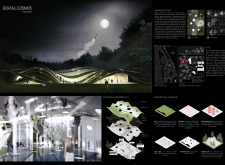5 key facts about this project
Digital Cosmos is a pavilion designed to represent the connection between digital and physical worlds, focusing on humanity's achievements in global connectivity through the internet. It is located at the Kennedy Space Centre Visitor Complex, close to key satellite launching sites. This position highlights the pavilion's role in a world increasingly dependent on digital communication, especially during critical times like the Covid-19 pandemic.
Architectural Concept
The pavilion translates digital qualities into a physical form. The design highlights timelessness and a lack of fixed location, reflecting the essence of digital spaces. Using transparency, translucency, and reflectivity, the structure interacts with light in ways that echo the fluidity of digital environments. This combination creates an inviting atmosphere that encourages exploration.
Spatial Organization
The layout includes multiple functional spaces, such as galleries, a cafe, workshops, an open theatre, and a reception area. This arrangement supports easy movement and promotes visitor interaction, making it suitable for group activities. A key feature is the "digital grid" overlaid on the floor plan, symbolizing the connections that data and individuals share within the digital landscape.
Interaction Spaces
Enclosed areas are designed as "bubbles of interaction," representing the various groups that operate in a digital network. These spaces encourage social interactions among visitors, reflecting the fragmented nature of digital communication. This design element emphasizes the importance of human connections in a digital age, inviting visitors to engage with one another as they explore the pavilion.
Light and Ambiance
Light tubes are integrated into the design as metaphors for fiber optics. They illuminate the spaces and enhance the overall experience. The perforated roof allows natural light to enter, creating a lively atmosphere inside. Artificial trees are placed thoughtfully throughout the pavilion, providing a contrast to the natural environment outside. This design choice highlights the pavilion's role as a link between the digital and physical realms.
The pavilion's careful use of light and open spaces fosters an inviting quality. Visitors are encouraged to navigate through and experience the interplay between technology and human interaction.



















































